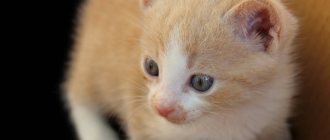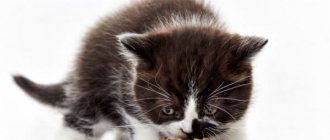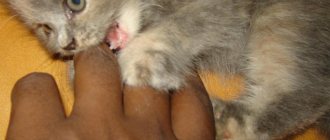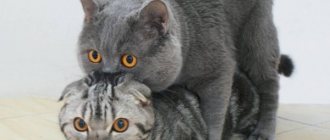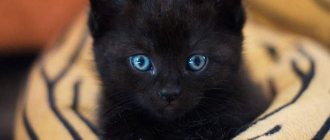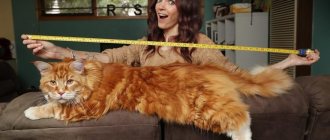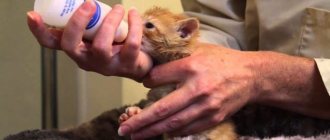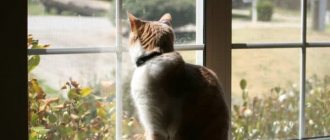10971Administration
1
A tiny fluffy ball, not yet able to do anything on its own, may appear in the house for various reasons: it was separated from its mother cat early, picked up on the street, turned out to be an orphan, etc. Naturally, the new owners who shelter him will be puzzled by questions: how to teach a kitten to eat on its own and what to feed it.
If the kitten has not yet reached the age of one month, the owner will have to do everything to at least partially replace the baby’s mother, because such a baby has not yet learned anything on his own, and somehow needs to eat in order to survive.
In fact, teaching a kitten to eat and drink is both a difficult and simple task.
It will take a lot of patience, there will be a number of sleepless nights, and the baby will not be able to learn everything right away. But natural instincts, inherent in furry babies from early childhood, always come to the aid of caring owners. They will speed up the process of accustoming the kitten to feeding on its own.
At what age do kittens start eating on their own?
In the first days of life, babies are breastfed and do not require special human care. Nutrition problems fall on the mother cat.
Little kittens are completely helpless, so the owner should be patient and pay special attention to how and what to feed the baby correctly
After 3 weeks, she will need the help of her owner, because the kittens are already becoming more active and independent, moving around the house, learning to go to the toilet.
From this moment on, the cubs are weaned from their mother's milk.
Important! Until about one month of age, kittens should be fed low-fat milk up to 8 times a day.
Features of feeding kittens at different ages
Pets aged 1-1.5 months are fed liquid food at least 5-6 times a day, the following dishes are suitable:
- Puree (vegetable or meat);
- liquid unsweetened semolina porridge;
- skim cheese;
- boiled yolk.
At 2 months, the animals have their baby teeth and can now be fed solid food. But it is impossible to exclude liquid food, since it is necessary for the proper functioning of the digestive system.
As an animal grows, its need for food and nutrients increases.
At 2 months you can already give the following food:
- lean boiled meat;
- cottage cheese;
- chicken yolk;
- milk;
- yogurt.
Food should be rich in vitamins and nutrients. From childhood, teach your pet to eat cereals and vegetables in addition to milk, fish and meat.
Be sure to read:
How cats die: signs, behavior before death, how to alleviate the condition, what to do
Possible problems
In addition to observing the norms and frequency of feedings, it is important to avoid prohibited foods. They can lead to disturbances in the gastrointestinal tract, accompanied by a complete refusal to eat.
An animal left without food for a long time may die.
Refusal to eat
If feeding problems occur in newborns, they must be checked by a veterinarian. Pathological reasons for refusing food at such an early age include:
- hypothermia, that is, low body temperature;
- intrauterine infection with leukemia, chlamydia or other dangerous diseases;
- too low weight associated with pathologies of the placenta;
- any intrauterine development disorders;
- internal injuries;
- hemolysis of newborns, accompanied by the destruction of red blood cells by antibodies supplied with colostrum.
If the baby has always had a good appetite, but increasingly refuses to eat after the introduction of complementary foods, then the problem may lie in:
- Stress
. Separating from the mother too early and abruptly switching to new food is harmful for the animal. - Allergies
. An allergic reaction is accompanied by rashes, hair loss, redness of mucous membranes and other alarming symptoms. To normalize the condition, the allergen is excluded from the diet. - Gastrointestinal disorder
. If vomiting and diarrhea occur, have your pet checked at a veterinary clinic. In addition to the usual eating disorder, worms or other parasites may be found in the body. - Incorrectly selected dishes
. The pungent smell of plastic and the presence of dirt are unacceptable for clean representatives of the cat family.
If any alarming symptoms appear, be sure to contact your veterinarian. Kittens are more vulnerable than adult pets, so any delay can cost them their lives.
Prohibited foods
The list of prohibited foods includes everything that appears on the human table: spices, pickles, smoked foods, fried foods, flour and sweets. You should also exclude:
- pork, often contaminated with worms and causing obesity;
- millet and pearl barley porridge, poorly digestible in the stomach;
- grapes (raisins) and mushrooms that can lead to poisoning;
- garlic and onions, which contribute to the development of anemia;
- sorrel, which causes an acute form of gastritis;
- any bones that injure the esophagus and intestines when swallowed;
- a family of legumes that cause increased gas formation.
Milk is removed from the diet by the age of one year. Closely monitor your pet's reaction to this product. If lactose intolerance develops earlier, then it is not necessary to wait a year. This condition is accompanied by severe bloating and diarrhea, so it is difficult to miss.
How to feed a newborn kitten
Nothing can replace breastfeeding for a baby, but if a kitten is weaned from its mother early, it will have to do without mother's milk.
Without mother's milk
Nothing can replace breastfeeding for a baby
. A newborn kitten left without a mother needs a cat's milk substitute. Royal Canin Babycat Milk or Beaphar Kitty-Milk. The instructions for use describe the procedure. After eating, massage your tummy to improve digestion. From three weeks of age, accustom your kitten to ready-made food or natural products.
Regular food
Choose food that contains vitamins and microelements necessary for the growth and development of the animal.
Suitable for the diet:
- Liquid milk porridges;
- Milk, cottage cheese;
- Boiled chicken or other lean meat, fish.
Gradually introduce dry food into your pet's diet. For young kittens you need to select special baby food.
What to feed a kitten?
Just feeding a kitten milk is not enough. He must receive from food all the necessary microelements and vitamins for normal development. When your baby is ready to eat on his own, his diet should look like this:
- Liquid porridge with milk (semolina, ground buckwheat).
- Dairy products.
- Boiled chicken or turkey, cut into small pieces.
- Thin slices of meat, processed with boiling water.
- Small pieces of boiled fish. The seeds are first removed.
The kitten should not be given fatty meat, sweets, flour, raw fish, or smoked foods. They can harm his health.
When the baby begins to eat on his own, he can also be given ready-made food made specifically for his age.
In the first months of life, a kitten can eat up to 7 times. At the same time, he eats up to 10 milliliters of milk or a couple of pieces of other food with each approach. Gradually, portions increase, and the number of meals may remain the same or decrease.
How to tell if a kitten is hungry
You can guess that an animal is hungry by its behavior. The first thing that gives away is the look. If your pet looks at you for a long time and incessantly, then it’s time to feed him. Loud meowing is also a signal that it is time for lunch or dinner.
If a cat repeatedly runs up to the bowl or to the place where it is fed and runs back, then this is also a hint that it is hungry. Some animals sometimes scrape their cup with their paws.
In order for the kittens to get used to the diet, the owner must remove the leftover food after a meal, then they no longer try to beg for a treat.
How to train kittens to eat on their own
Animals at the age of 3 weeks already show interest in the food of adult cats . This is a good time to start complementary feeding and teach your baby to eat from a saucer.
How to accustom a kitten to a bowl?
To do this, pour a small amount of warm milk into a saucer, wet your finger and let the kitten lick it. Afterwards, place the baby near the bowl and gently poke his muzzle into the milk.
Be sure to read:
A cat yells at night: what to do, the main reasons, how to calm the animal, what not to do
Animals at the age of 3 weeks already show interest in the food of adult cats
At first, the kitten may sneeze or snort or blow bubbles, but over time he will adapt to lapping from the bowl. If your pet tries to climb into the saucer with its legs, then immediately prohibit it in order to accustom it to order.
Sometimes the pet refuses to eat on its own. The reason is that he was weaned from breastfeeding prematurely. In this case, it is better to give the baby food from a pipette again or return him to his mother and try to repeat the training after a while.
How to accustom a kitten to a change in diet?
The menu should be varied. Teaching a kitten to eat something new is not that difficult.
Follow the recommendations:
- New products are added gradually.
- Small portions of a new product for the kitten are mixed with the usual food.
- If your pet does not immediately try the unusual food, then it is better to feed it by hand.
- If the cat refuses this food, then it is better not to insist and try to introduce something else into the menu.
What can and cannot be given to a kitten?
In order for your pet to grow strong and healthy, nutrition must be balanced. Be sure to include fish or lean meat, dairy products, and cereals in your diet. Consult your veterinarian for vitamin supplements.
Important! Fatty meats, sweets, flour dishes, raw fish, and smoked foods are contraindicated for cats.
Classification and features of industrial feeds
On mobile, you can scroll the table horizontally with your finger.
| Name | Advantages | Flaws |
| Economy class Diamond meal Doctor Zoo Vaska Whiskas Darling, etc. | low cost |
|
| Premium class Nutro nuggets Flatazor Pro Pac Happy Cat Royal Canin Doctor Alders, etc. |
|
|
| Super-premium class ProPlan Petreet Hills Nutro Choice Royal Canin Bosh, etc. |
| the cost is quite high |
| Holistics Innova Acana Canidae Eagle Pack Holistic Select Felidae, etc. |
| the cost is high, not affordable for everyone |
Economy or medium class food refers to a type of industrial food that is secretly called fast food for representatives of the cat world. This is the cheapest, most budget option, which has many disadvantages. Such food is made from the cheapest, low-quality products.
There is practically no meat in the composition. The meat part is represented mainly by waste. To enhance the taste of these products, chemical preservatives, flavor enhancers, flavorings, as well as catnip, which is an analogue of valerian, are added to the composition. Giving such food on a regular basis is highly discouraged, as this can lead to serious problems with the digestive system and health of the animal.
Super-premium class - they cost more than economy class, but they do not always meet the requirements. The advantage of such foods is that they do not contain food colors or flavors. They contain more meat than in economy category feeds, and the taste is a level higher. These types of feeds are quite well accepted by the animal’s digestive system.
Holistics are the most expensive class of cat food, but their quality is appropriate. The composition contains a large amount of natural, good meat. No dyes or flavor enhancers. The composition of the food fully corresponds to natural nutrition.
Recommended canned foods
On mobile, you can scroll the table horizontally with your finger.
| Name of food | Advantages | Flaws |
| Bosh Sababelle Super premium class |
| The food contains large quantities of maize and cellulose - components that can provoke a food allergy in a kitten. |
| Pro Plan Junior Premium class |
| The composition contains a high concentration of protein of plant origin. The food contains corn and soy - products that provoke allergic reactions. Preservatives are also present in the composition. |
| Hills Premium class |
| A high concentration of carbohydrates, which are poorly absorbed by the kitten’s digestive system, there are components that can cause allergies, canned food contains a lot of water and broth. |
A few necessary recommendations
It is difficult for your kitten to feed himself if the dishes are awkward or large, so you should choose dishes that are the right size and that are stable on the floor. This way the baby will feel more comfortable and will eat more willingly.
Don't forget the following simple rules:
- A saucer of water should be placed near the bowl of food.
- You cannot force a kitten to eat.
- Do not mix dry food with regular food. This can only be done when switching from one food to another.
On a note! The kitten will refuse food that is too hot or, on the contrary, cold . Food should be at room temperature.
Tray selection
Choosing a tray is a responsible matter; today stores offer a wide selection of containers of different shapes and sizes. Since kittens grow very quickly, it is worth purchasing a large tray right away so that in the future your pet will not have difficulties going to the toilet. The quality of the product itself largely depends on the strength of the plastic used.
The modern market offers several types of litter boxes for cats. They vary in size, functionality and design.
The height of the tray also matters; the sides should not be too low. Otherwise, all the filler may end up on the floor. Too high sides will cause a lot of inconvenience for your pet and complicate the process of accustoming to the tray.
By type, toilets are divided into open and closed. In the first case, the product is a square or rectangular tray with sides around the perimeter.
Important! Kittens do not like cramped containers. If the pet realizes that the tray is inconvenient for him, he will find another place.
With filler
Having decided on the tray, you should take care of the filler. If previously ordinary sand from a sandbox or torn newspapers were used for these purposes, today there are many fillers on sale with different functions. The main types are:
- Absorbent filler. The most budget option, the filler absorbs liquid well and prevents the appearance of unpleasant odors. These look like large pebbles (they are actually clay) that resemble small sea pebbles. Due to its size, the filler does not stick to the kitten’s paws and does not spread around the apartment.
The only drawback is the high consumption of filler.
- Clumping filler. In appearance it resembles sand or small granules, although in fact it is still the same clay. When urine enters, it engulfs the source of moisture, forming a lump. This type of filler is quite convenient, since it is enough to simply remove the lump from the tray.
The downside is that it stays on the cat’s paws because of its stickiness and spreads throughout the apartment.
- Wood filler. It is worth saying that such a filler does not block the smell very well, but it does not remain on the pet’s paws and is the most natural of all.
Wooden cat litter is a convenient invention that pets and their owners like.
- Silica gel fillers. They hide the smell well and changing it once a month is enough. However, its cost is quite high, and cats make a lot of noise when using it.
Silica gel filler is rightfully considered one of the most convenient and high-quality.
No filler
Some owners prefer trays without filler, in which case the container will have a grid. This type of tray has a number of advantages:
- you can always see when, what and how the cat went to the toilet, which makes it possible to monitor the pet’s health;
- you can clean the tray in a timely manner, so the kitten will always go to a clean container;
- saving money because there is no need to purchase filler.
Some models have a removable mesh that prevents your pet from scattering the litter on the floor.
The difficulty arises from the fact that you have to constantly monitor the filling of the tray, because the kitten may refuse to go into a dirty container.
The tray needs to be cleaned after the cat has gone into it, since the unpleasant smell causes hostility in such clean animals.
Important! It is better to place a tray for a small kitten in the room where he spends the most time.
